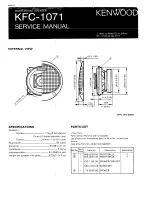
en
13
transported separately from one an-
other.
■
Check the device and all accessories
for damage on a regular basis. If you
notice any damage to the device (e.g.
cracks in the housing), CO
2
cylinder
(e.g. dents in the CO
2
cylinder) or the
water bottle, or in the event of a fault,
you must contact the customer service
department. The device must not be
used until it has been repaired as this
may result in a malfunction of the de-
vice and can increase the risk of injury.
■
Do not make any modi
fi
cations to the
device, CO
2
cylinder, water bottle or
the other accessories. Never attempt
to repair parts of the system yourself to
avoid any hazards! Repairs may only
be carried out by the authorised cus-
tomer service department, otherwise
all warranty and guarantee claims
shall be void.
■
Store the device and accessories in a
cool place (but not below 1°C) and do
not expose to temperatures of more
than 40°C (CO
2
cylinder up to 50°C,
glass bottle up to 85°C). Keep away
from
fi
re, heat sources (e.g. hobs or
ovens) and direct sunlight.
■
Do not expose the device and acces-
sories to strong temperature
fl
uctua-
tions, persistent moisture or collisions.
■
Always place the device on a level,
stable and water-resistant surface.
■
The device must be upright during use.
■
The device may only be operated with
the water bottle inserted and
fi
lled with
water.
■
Do not move the device during use.
■
Never place heavy objects on the de-
vice or accessories.
■
Note the cleaning instructions in the
“Cleaning and Storage” chapter!
■
The device does not have an unlimit-
ed lifespan as it contains moving parts
and operates under high pressure.
Unless it has obvious defects, it is rec-
ommended that the device should be
replaced no later than 7 years after the
purchase date. If this is not done, risks
that pose a hazard to health and safety
may arise.
CO
2
Cylinder
CO
2
cylinder
• contains gas under pressure.
• may explode if heated.
• should be stored in a well-ven-
tilated place! The gas is suffo-
cating in high concentrations.
WARNING – Danger of Suffo-
cation!
Carbon dioxide may escape from
a damaged CO
2
cylinder. This
can lead to suffocation in rooms
with poor ventilation. If you feel
dizzy or sick, ventilate the room
in which the device is located
with plenty of air. Go outside,
breathe fresh air and visit a doc-
tor if necessary.
CAUTION
– Cold Burns!
Do not touch the CO
2
cylinder
when gas is escaping (as it might
be very cold), leave it in the de-
vice and allow it to empty in a
well-ventilated place or outdoors
for around a day. Contact our
customer service department.
If the CO
2
cylinder is iced up,
avoid any body contact and do
not use the CO
2
cylinder!
■
Follow the labels on the CO
2
cylinder!
■
The CO
2
cylinder must not get into the
hands of children!


































